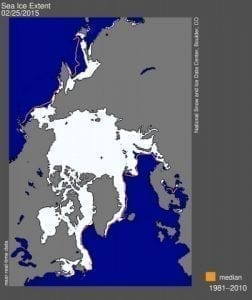 Preliminary analysis from the National Snow & Ice Data Center (NSIDC) in Boulder, Colorado shows that Arctic sea ice likely reached its seasonal maximum on February 25th. At 5.61 million square miles (14.54 million square kilometers) the expected maximum ice extent is the lowest in the satellite record.
Preliminary analysis from the National Snow & Ice Data Center (NSIDC) in Boulder, Colorado shows that Arctic sea ice likely reached its seasonal maximum on February 25th. At 5.61 million square miles (14.54 million square kilometers) the expected maximum ice extent is the lowest in the satellite record.
The maximum extent for 2015 is 425,000 sq. miles (1.10 sq. kilometers) below the 1981-2010 average and 50, 200 sq. miles (130,000 sq. kilometers) below the previous low maximum of 2011.
This year’s maximum extent was 15 days earlier than the 1981-2010 average date of March 12. There is often a wide year-to-year variation of the date of maximum extent, with the earliest recorded ice extent on February 24, 1996 and the latest on April 2 of 2010.
Sea ice extent grew a total of 3.83 million sq. miles (9.91 sq. kilometers) over the 2014-2015 winter season. Part of the reason for the record low ice extent is due to recent weather patterns over the region, NSIDC explains in its report. The jet stream maintained an “unusual configuration” for most of February creating warmer-than-average conditions for the Pacific side of the Arctic.
From late February though mid-March, a strongly positive Arctic Oscillation pushed temperatures in the mid-troposhere (about 3,000 feet of altitude, or the “925 hPa” level) as much as 14 to 18 degrees Fahrenheit above average in the Barents Sea between Svalbard and Franz Josef Land.
While there is still a chance for more seasonal ice growth, scientists feel it is unlikely as March draws to a close. The NSIDC will release a final analysis of Arctic winter conditions in early April.


